Saturday, September 4, 2010, hit 100 degrees by 11 a.m., but that didn’t stop over 70 people from participating in the dedication of “Remembering Our Ancestors” Memorial Wall and Dedication Garden at Evergreen Cemetery in East Los Angeles. Dignitaries like L.A. County Supervisor Mike Antonovich, Assemblyman Mike Eng, and Congresswoman Judy Chu also attended, representing the broad alliance and political representation to honor past Los Angeles pioneers of Chinese ancestry, whose graves were accidentally found during the building of the light rail Gold Line (L.A. County Metro Rail System). Supervisor Antonovich symbolically asked for forgiveness for what had happened to these Chinese pioneers, on behalf of L.A. county. Taoist practitioners performed ceremonial rites to honor these unknown pioneers of Los Angeles. The monuments are tri-lingual—English, Chinese, and Spanish—to honor the many Latino/a and other pioneers who were also buried at the potter’s field. Grave markers for the unknown are placed before the larger monument inside the cemetery proper, where participants were given flowers to place on each marker. The larger site inside Evergreen proper was built as part of the L.A. Historic/Cultural Monument Number 486, which was built in 1888 and restored in 1997.
Ching Ming events have been held in previous years leading up to this formal day of dedication with the completion of the monuments. I attended last year’s Ching Ming, and after lunch, we took a walk to another part of the cemetery to view Donaldina Cameron’s gravesite, with one of the slave girls that she saved buried a couple of plots from hers. Before leaving Evergreen, my husband and I went to visit my grandparents’ and uncle and aunt’s graves in the Japanese section of Evergreen, only to find that my Grandmother’s headstone had been shifted off-center from its cement base.
Cheers to Chinese Historical Society, and lead organizer, Gilbert Hom, for helping complete the efforts of former President Irvin Lai. These kinds of discoveries of unmarked graves shows how history gets covered over, buried, and forgotten. With good luck, generations later, they are rediscovered and reestablished by those who are willing to fight for a more accurate history.
Keep watch for Part 2 on last year’s Ching Ming event at Evergreen Cemetery. For more information on this event: email Gilbert Hom at gilberthom@hotmail.com
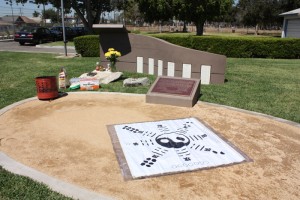
Taoist practitioners blessed the outside monument first. An assortment of symbols and food bring good wishes to the ancestors.
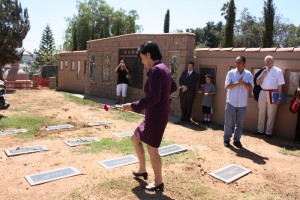
Congresswoman Judy Chu places flower on one of the symbolic headstones accompanying monument dedicated to the ancestors. Organizer Gilbert Hom (at right) and County Supervisor Mike Antonavich (behind Gilbert) look on.
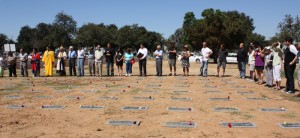
Participants join together around the symbolic markers while the site is blessed by local American Indians representing the original keepers of the land, followed by Taoist practitioners.
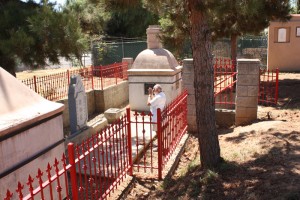
Veteran community activist Mo Nishida pays respects to the ancestors at Los Angeles Historic/Cultural Monument No. 486, which is part of the dedication site.
Text of Plaque on the Outside Monument:
Memorial to the Unknown Pioneers of Los Angeles,
In 1877, Evergreen Cemetery granted an undeveloped rear section of its property to the City of Los Angeles for indigent burials. Over 10,000 souls were interred in this potter’s field. Chinese were buried in a separate section, and due to discrimination, were charged for each burial. The Chinese community held seasonal rites and memorial ceremonies, and built a shrine in September 1888. The Shrine still stands at its original site, as Los Angeles Historic/Cultural Monument No. 486.
By 1924, all burial space in the indigents’ cemetery was exhausted. A crematorium was built by the County of Los Angeles; unclaimed deceased or indigents were henceforth cremated. Remaining wooden markers and headstones in the potter’s field were removed or covered over. In 2005, a section of the cemetery was excavated during the construction of the light rail line. Over 186 gravesites were disturbed, the skeletal remains of more than 130 individuals were removed, and grave markers of deceased Chinese persons were found lining a roadway of the Crematorium.
This memorial is dedicated to these Los Angeles pioneers with the hope that their final resting place will be remembered and treated with utmost respect.
Boyle Heights Historical Society
Chinese Historical Society of Southern California
Chinese American Museum
Chinese American Citizens Alliance L.A. Lodge
Chinese Consolidated Benevolent Association
The First Taoism Foundation
Studio for Southern California History
County Supervisor Gloria Molina, First District
County of Los Angeles Department of Health Services
September 2010
See Amerasia Journal 34:1 (2008) for articles on researching Chinese American ancestry by Catherine Gow and William Gow.
See Amerasia Journal 36:2 (2010) for Mayu Kanamori’s photo/essay on Japanese burial sites in Australia. Email orders for this issue: aascpress@aasc.ucla.edu
All photographs: © Mary Uyematsu Kao, 2010

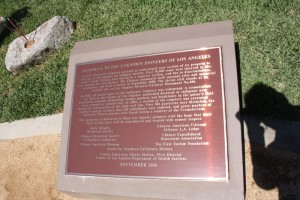
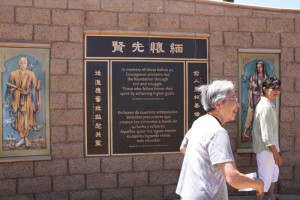
 Amerasia on Facebook!
Amerasia on Facebook!